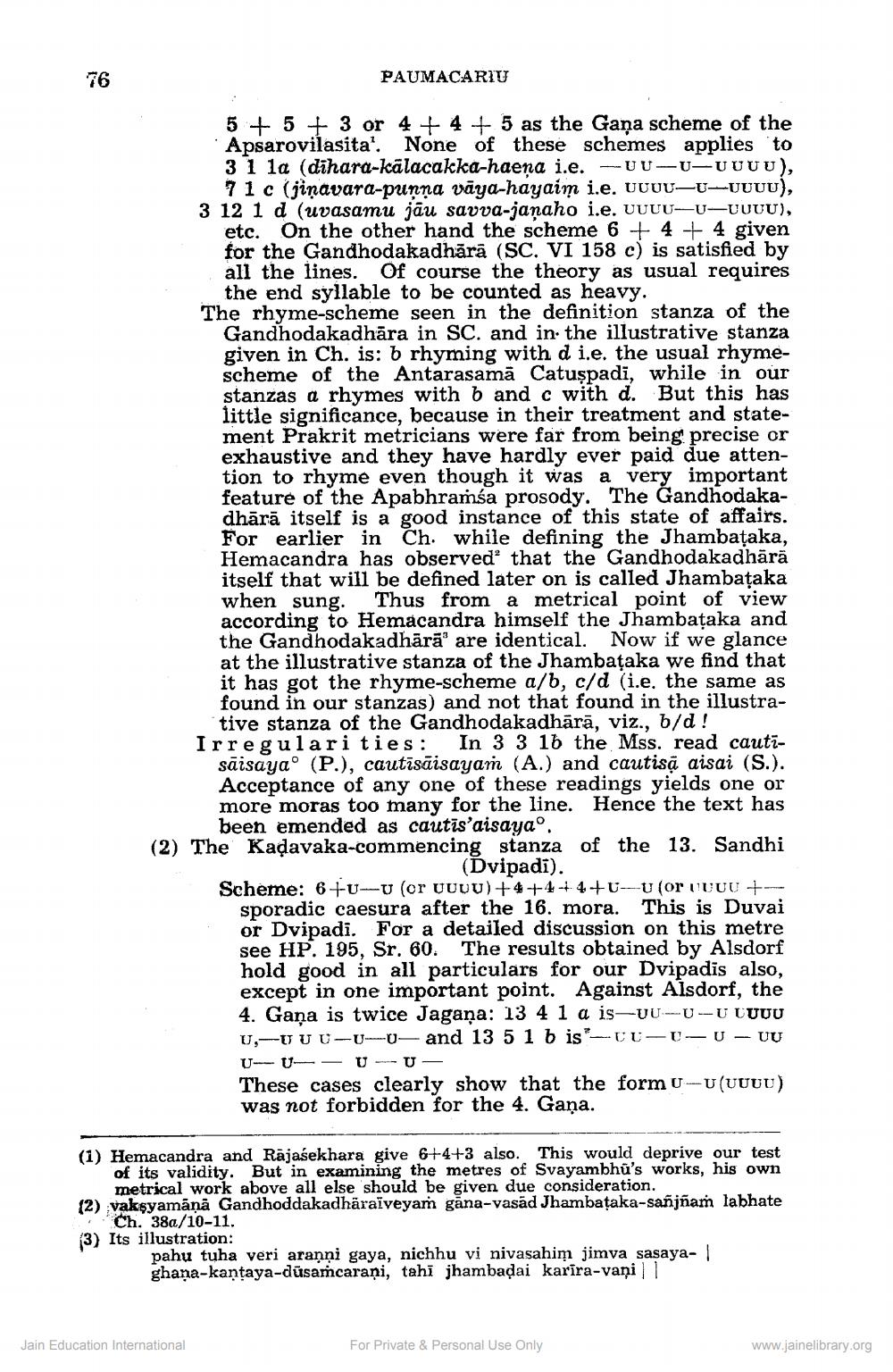________________
76
PAUMACARIU
5 + 5 + 3 or 4 + 4 + 5 as the Gana scheme of the Apsarovilasita'. None of these schemes applies to 31 la (dihara-kalacakka-haena i.e. --UU-U-UUUU),
71 c (jiņavara-punna vāya-hayaim i.e. UUUU—U-UUUU), 3 12 1 d (uvasamu jāu savva-janaho i.e. UUUU-UUUUU),
etc. On the other hand the scheme 6 + 4 + 4 given for the Gandhodakadhārā (SC. VI 158 c) is satisfied by all the lines. Of course the theory as usual requires
the end syllable to be counted as heavy. The rhyme-scheme seen in the definition stanza of the
Gandhodakadhāra in SC. and in the illustrative stanza given in Ch. is: b rhyming with d i.e. the usual rhymescheme of the Antarasamā Catușpadi, while in our stanzas a rhymes with b and c with d. But this has little significance, because in their treatment and statement Prakrit metricians were far from being precise or exhaustive and they have hardly ever paid due attention to rhyme even though it was a very important feature of the Apabhramsa prosody. The Gandhodakadhārā itself is a good instance of this state of affairs. For earlier in Ch. while defining the Jhambataka, Hemacandra has observed that the Gandhodakadhārā itself that will be defined later on is called Jhambataka when sung. Thus from a metrical point of view according to Hemacandra himself the Jhambataka and the Gandhodakadhārā' are identical. Now if we glance at the illustrative stanza of the Jhambațaka we find that it has got the rhyme-scheme a/b, c/d (i.e, the same as found in our stanzas) and not that found in the illustra
tive stanza of the Gandhodakadhārā, viz., b/d! Irregularities: In 3 3 16 the Mss. read cauti
säisayao (P.), cautīsāisayam (A.) and cautisą aisai (S.). Acceptance of any one of these readings yields one or more moras too many for the line. Hence the text has
been emended as cautīs'aisayao. (2) The Kadavaka-commencing stanza of the 13. Sandhi
(Dvipadi). Scheme: 6+U--u (or UUUU)+4+4+4+U--u (or UUUU +
sporadic caesura after the 16. mora. This is Duvai or Dvipadi. For a detailed discussion on this metre see HP. 195, Sr, 60. The results obtained by Alsdorf hold good in all particulars for our Dvipadis also, except in one important point. Against Alsdorf, the 4. Gana is twice Jagaņa: 13 4 1 a is-UU-U-UUUUU U UUU-UU- and 13 5 1 b is-UU-U-U-UU U- U- - U- UThese cases clearly show that the form U(UUUU) was not forbidden for the 4. Gana.
(1) Hemacandra and Rajasekhara give 6+4+3 also. This would deprive our test
of its validity. But in examining the metres of Svayambhu's works, his own
metrical work above all else should be given due consideration. (2) vaksyamāna Gandhoddakadhāraiveyam gāna-vasad Jhambațaka-sañjñam labhate
Ch. 380/10-11. (3) Its illustration:
pahu tuha veri araņņi gaya, nichhu vi nivasahim jimva sasaya- ghana-kantaya-dūsamcarani, tahi jhambadai karira-vanill
Jain Education International
For Private & Personal Use Only
www.jainelibrary.org




